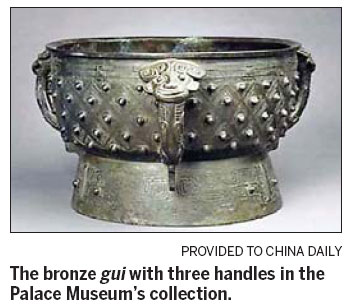Getting to grips with a rare gui that has three handles
Updated: 2012-01-05 08:02
By Cheng Anqi (China Daily)
|
|||||||||||
Editor's Note: Every week we look at a work of art or a cultural relic that puts the spotlight on China's heritage.
 |
A gui is an ancient round-mouthed food vessel with two to four looped handles, or ears, used for ceremonial rites during the Shang and Zhou dynasties (c.16th century-221 BC).
The early bronze gui had no handles on the sides. Later, gui became comparatively large, and their ears served not only as handles but also as spaces for elaborate motifs.
 |
Nobles often needed more than one gui to host feasts or offer sacrifices.
Between two and 12 of the vessels were used in banquets but the number was always a multiple of two, ancient texts say.
A rare bronze gui with three handles is in the Palace Museum's collection. The 19.1-cm-tall vessel weighs 6.94 kg. It has a wide, flared mouth, a 13-cm-deep bowl and a tall round base.
Its base is filled with huiwen, or spiral patterns, but the dominant design features "nipples" within rhombuses, and animal masks and eyes.
It retains the basic features typical of the Shang Dynasty (c.16th century-11th century BC) gui that don't have handles.
The unusual features are the three handles that bear the shapes of human faces between the mouth and base.
The spiral meander is formed by lines that continuously turn in on themselves.
This motif was only used on a vessel's neck or foot. It wasn't until the late Shang that it served as the grounding to offset the principal ornament.
Most gui - all of the earlier vessels - have only two handles. Four-eared gui came later.
But three-handled gui, such as the one in the Palace Museum's collection, are rare treasures, indeed.
Today's Top News
Rescuers race against time for quake victims
Telecom workers restore links
Coal mine blast kills 18 in Jilin
Intl scholarship puts China on the map
More bird flu patients discharged
Gold loses sheen, but still a safe bet
US 'turns blind eye to human rights'
Telecom workers restore links
Hot Topics
Lunar probe , China growth forecasts, Emission rules get tougher, China seen through 'colored lens', International board,
Editor's Picks

|

|

|

|

|

|





